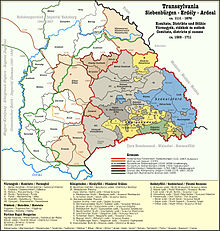
Back فويفود ترانسيلفانيا Arabic Erdélyi vajda Hungarian Vojvoda van Zevenburgen Dutch Listă de voievozi ai Transilvaniei Romanian Erdel Voyvodalığı Turkish

The Voivode of Transylvania (German: Vojwode von Siebenbürgen;[1] Hungarian: erdélyi vajda;[1][2] Latin: voivoda Transsylvaniae;[1][2] Romanian: voievodul Transilvaniei)[3] was the highest-ranking official in Transylvania within the Kingdom of Hungary from the 12th century to the 16th century. Appointed by the monarchs, the voivodes – themselves also the heads or ispáns of Fehér County – were the superiors of the ispáns of all the other counties in the province.
They had wide-ranging administrative, military and judicial powers, but their jurisdiction never covered the whole province. The Saxon and Székely communities – organized into their own districts or "seats" from the 13th century – were independent of the voivodes. The kings also exempted some Transylvanian towns and villages from their authority over the centuries. Even so, the Voivodeship of Transylvania "was the largest single administrative entity"[4] in the entire kingdom in the 15th century. Voivodes enjoyed income from the royal estates attached to their office, but the right to "grant lands, collect taxes and tolls, or coin money"[5] was reserved for the monarchs. Although Roland Borsa, Ladislaus Kán and some other voivodes rebelled against the sovereign, most remained faithful royal officials.
Because of the gradual disintegration of the medieval Kingdom of Hungary in the 16th century, the last voivodes of Transylvania, who came from the Báthory family, ceased to be high-ranking officials. Instead they were the heads of state, although under Ottoman suzerainty, of a new principality emerging in the eastern territories of the kingdom. Accordingly, Stephen Báthory, the voivode elected by the Diet of the new realm, officially abandoned the title of voivode and adopted that of prince in 1576, upon his election as King of Poland.
